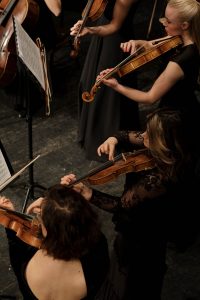Women & The Orchestra
Words by Kate Hamori
If you take a look at your average symphony concert program, you’re likely to notice a pattern: the majority of the composers that appear on orchestra concerts are white men. This isn’t because women aren’t composing—trust me, we are. This pattern simply reflects how classical music is often evaluated from the cultural standpoint of the social majority—that is, the white male perspective.
Like most issues of gender inequality, underrepresentation of women’s music is systemic. For example, it may begin with a lack of access to formal education and training that many women composers like Amy Beach encountered. Then, there are the desires and commands of fathers and husbands who placed limits on the musical ambitions of their daughters and wives. Next, you might run into bias from publishers and critics. After enough bad reviews, no orchestra will dare to touch your music, and just like that, the door to the Western art music canon slams shut.
Some orchestras have tried to mitigate this by organizing concerts entirely dedicated to women composers. These efforts are likely well-intentioned, but they can actually do more harm than good, providing the illusion of progressive programming while deepening the divide between “music” and “women’s music.” Musicologist Rebecca Lentjes writes, “The problem with amplifying the voices of “women composers” only as female voices is that it reifies the difference and ‘Otherness’ of these voices in a manner that simply reinforces the gender binary rather than dissolving it.” (You can read more of Rebecca’s incredibly astute and important work here.)
Sexism and discrimination affect women in all fields of music, including the instrumentalists that make up our orchestras. In 1930, harpist Edna Phillips became the first woman to belong to a major American orchestra, earning a spot at the Philadelphia Orchestra. But not all orchestras were so quick to integrate women into their forces. For example, the Vienna Philharmonic had an explicit policy against hiring women performers until 1996, when the Austrian government threatened to pull their funding if the policy continued. It then took the Philharmonic an additional seven years to hire their first woman performer, violist Ursula Plaichinger, in 2003.

In 1970, women made up about six percent of the top five American orchestras. As of 2019, women now claim about forty percent of orchestral positions in the U.S. This massive change over the past fifty years is largely due to the adoption of blind auditions, in which orchestral auditions are held anonymously to prevent bias from the jury. (However, we still have a long way to go when it comes to diversity in orchestras.)
Women conductors have also been subjected to a glass ceiling held up by systemic bias and unfounded scrutiny, not to mention sexist microaggressions and, on occasion, blatant misogyny in the workplace. In a 2013 interview, conductor Vasily Petrenko (who had recently been appointed chief conductor of the Oslo Philharmonic) stated that men conductors “often have less sexual energy and can focus more on the music. A sweet girl on the podium can make one’s thoughts drift towards something else.” Petrenko, who still holds his position at the Oslo Phil, later stated that he was referring specifically to orchestral conducting culture in his home country of Russia, though I struggle to understand how that would excuse such blatantly sexist comments.
I have to admit: as a young woman, I sometimes feel powerless against the systemic misogyny and bias that permeates my everyday life. I may not be able to change the face of the American orchestra overnight, but I can continue to broaden my own engagement with women’s music in my listening practices, my performances, my schoolwork, and my conversations about music. I hope you’ll join me. In the words of the late Justice Ruth Bader Ginsburg, “Real change, enduring change, happens one step at a time.”







That’s memorable !
As a young musician, I can have clearly in my mind how challenged it was for all women.
Thank you for those informations.